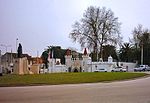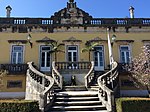Coimbra University Stadium

The Coimbra University Stadium (Portuguese: Estádio Universitário de Coimbra), or EUC, is an extensive sports complex of the University of Coimbra on Mondego's left bank, in Santa Clara parish, in the city of Coimbra, Portugal. The stadium was opened in 1963.It has 2 football (soccer) fields, one of them with an athletics track, a rugby union field, gymnasiums, tennis courts, a Radio-Controlled car track, and two multisports pavilions for play indoor sports such as basketball, handball, rink hockey, and volleyball. The Faculdade de Ciências do Desporto e Educação Física da Universidade de Coimbra, the sports sciences faculty of the University of Coimbra, is located there, and includes library and restaurant for the student community.
Excerpt from the Wikipedia article Coimbra University Stadium (License: CC BY-SA 3.0, Authors, Images).Coimbra University Stadium
Avenida de Conímbriga, Coimbra Santa Clara (Santa Clara e Castelo Viegas)
Geographical coordinates (GPS) Address External links Nearby Places Show on map
Geographical coordinates (GPS)
| Latitude | Longitude |
|---|---|
| N 40.20598 ° | E -8.43475 ° |
Address
Estádio Universitário de Coimbra/Faculdade de Ciências do Desporto e Educação Física
Avenida de Conímbriga
3040-256 Coimbra, Santa Clara (Santa Clara e Castelo Viegas)
Portugal
Open on Google Maps









